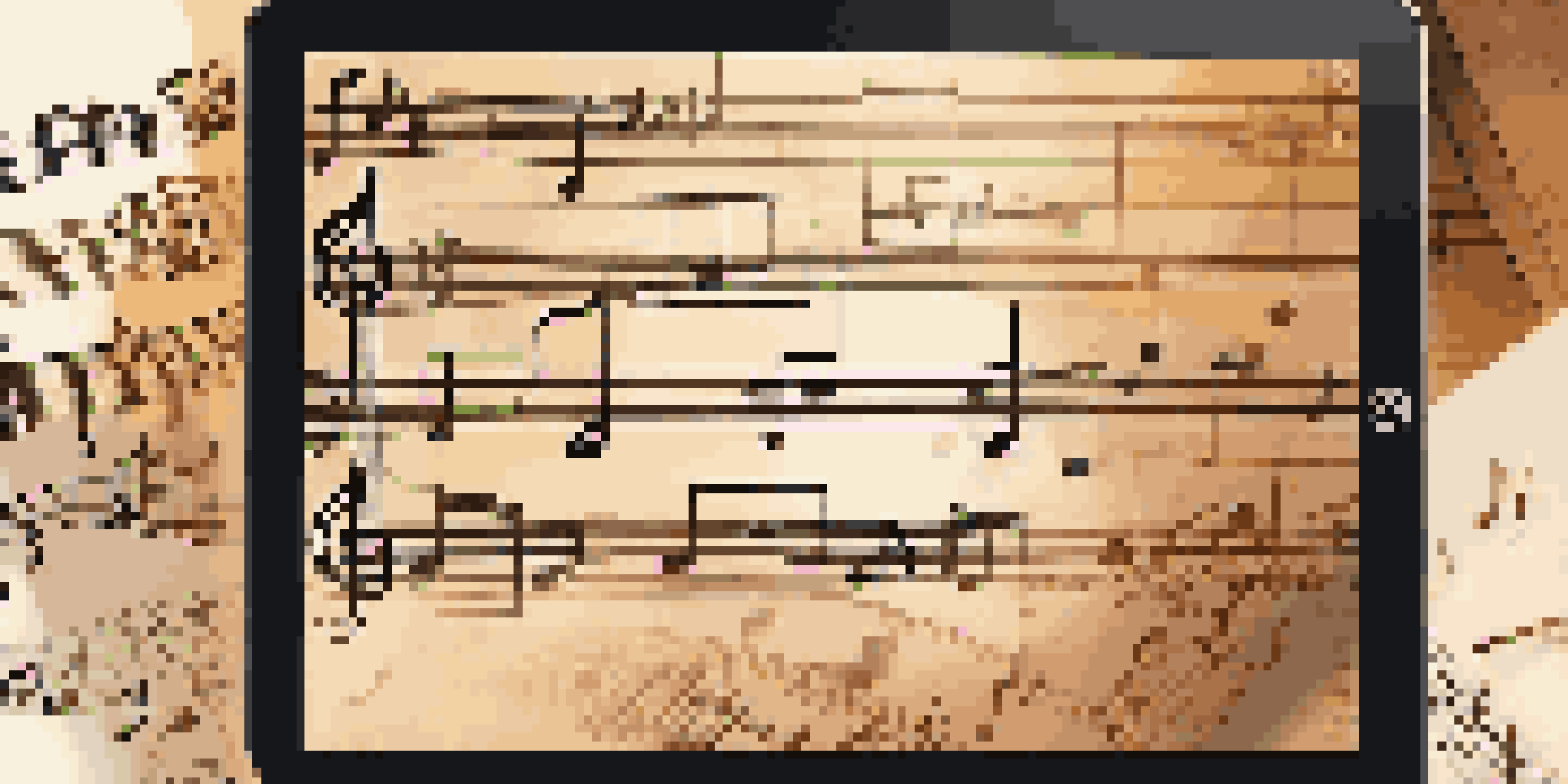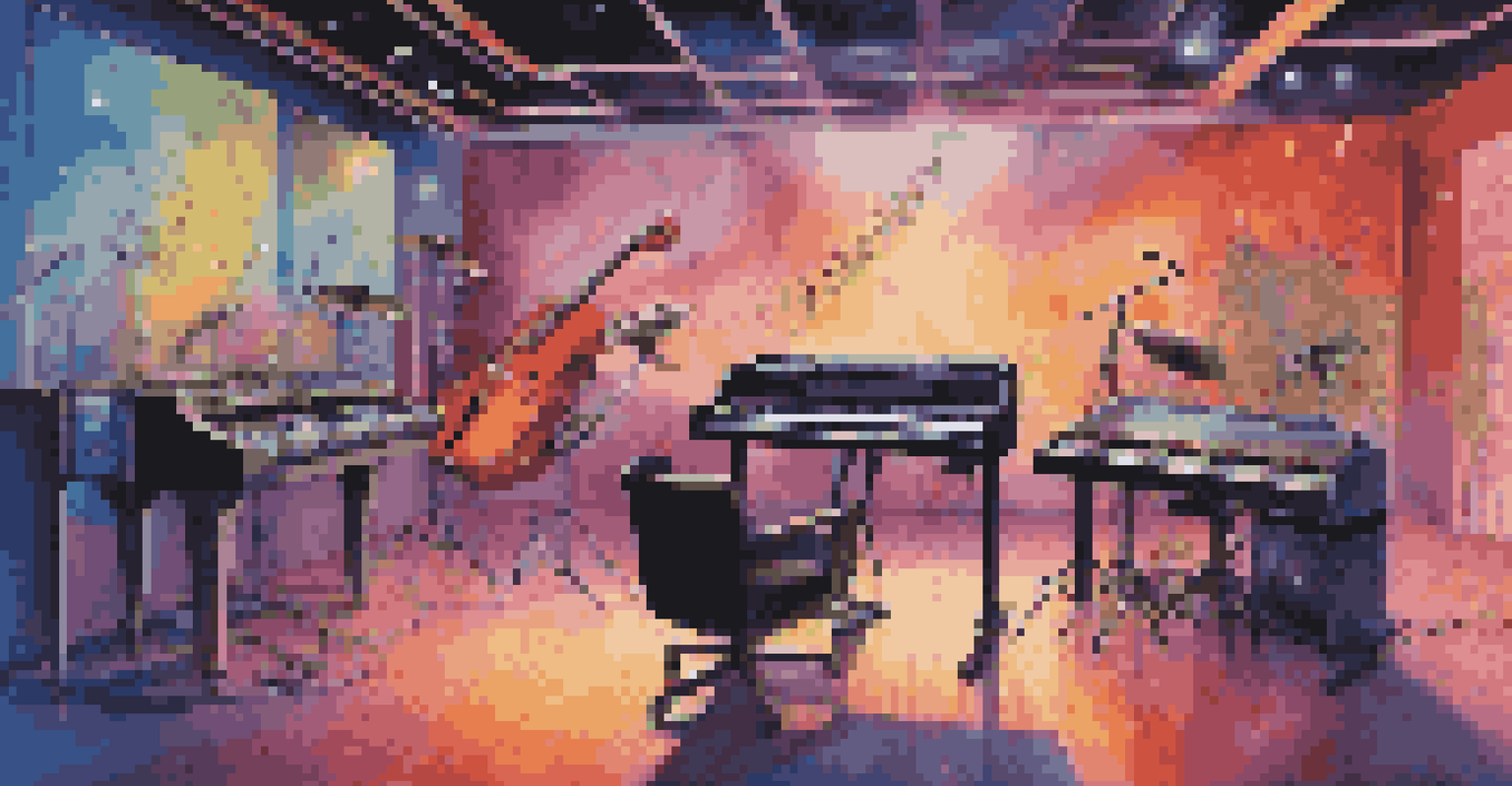Exploring the Use of Music Notation in Video Game Soundtracks

The Evolution of Music Notation in Gaming
Music notation has come a long way since the early days of video games, where chiptunes ruled the soundscape. Initially, composers had to work within strict limitations, using simple waveforms to create melodies. As technology advanced, so did the complexity of music notation, allowing for richer and more immersive soundtracks.
Music can change the world because it can change people.
Today, composers can create elaborate scores that rival those found in film. This evolution reflects not just technological advancements but also a growing recognition of music's role in storytelling within games. The transition from 8-bit beeps to orchestral arrangements has transformed how players experience narratives.
Moreover, the integration of music notation into game design has become more sophisticated. Composers now collaborate closely with developers to ensure that the music enhances gameplay, creating a symbiotic relationship between sound and visual storytelling.
Understanding Music Notation Basics
At its core, music notation is a symbolic representation of music, allowing composers to communicate their ideas clearly. Traditional notation involves the use of staff lines, notes, and various symbols to indicate pitch, rhythm, and dynamics. This foundational knowledge is essential, even for video game composers who may also utilize digital tools.

In video games, notation can sometimes take on a different form, resembling a visual score that integrates both sound and gameplay elements. This adaptability allows composers to convey complex musical ideas while also considering how players will interact with the music. Understanding these basics is crucial for anyone looking to delve into the world of game soundtracks.
Music Shapes Game Narratives
The evolution of music notation has transformed video game soundtracks into intricate scores that enhance storytelling and player engagement.
The use of software tools has also simplified the notation process. Programs like Sibelius and Finale allow composers to create, edit, and playback scores easily, making it simpler to experiment with different musical ideas and arrangements.
The Role of Composers in Video Game Development
Composers in the gaming industry wear many hats, acting as both musicians and storytellers. Their job is not just to create catchy tunes but to weave music into the fabric of the game, enhancing emotional depth and player engagement. A well-composed score can elevate a game's narrative and make the player feel more connected to the story.
The music is not in the notes, but in the silence between.
Collaboration is key, as composers often work alongside designers, artists, and writers to ensure that the music aligns with the overall vision of the game. For example, in an action game, the music may shift dynamically based on the player's actions, creating a more immersive experience. This level of integration showcases the importance of music notation in crafting a responsive soundtrack.
Furthermore, the composer must also consider the gameplay mechanics when composing. This means that music must be flexible enough to adapt to different scenarios while still maintaining thematic coherence throughout the game's narrative.
Dynamic Music and Interactive Notation
One of the most exciting aspects of modern video game soundtracks is dynamic music, which adapts in real-time based on player actions. This interactivity requires a new approach to music notation, as composers must create multiple variations of themes that can seamlessly transition during gameplay. Think of it as composing a musical choose-your-own-adventure.
For instance, in a horror game, the tension might be heightened by introducing dissonant chords as players approach a scary moment. The notation for such a piece would need to account for various states of gameplay, ensuring that the music evolves naturally alongside the player's journey. This leads to a more engaging and personalized gaming experience.
Dynamic Scores Adapt to Play
Modern video game music utilizes dynamic notation, allowing soundtracks to change in real-time based on player actions and decisions.
Interactive notation systems can also allow for branching paths, where players can influence the music based on their choices. This evolving relationship between player and music not only enriches the gaming experience but also showcases the innovative use of notation in a digital environment.
The Impact of Music Notation on Game Atmosphere
Music notation plays a crucial role in shaping the atmosphere of a game. By carefully crafting scores that align with the game's setting, composers can evoke specific emotions, making players feel more immersed. For example, a serene landscape may be complemented by gentle strings, while a dark dungeon could be underscored by ominous brass and percussion.
The atmosphere created by music can also influence gameplay. In puzzle games, for instance, a calm and steady score can help players focus, while an upbeat tempo in a racing game can enhance excitement and adrenaline. This relationship between music notation and atmosphere is vital for creating a cohesive gaming experience.
Moreover, soundtracks that effectively use notation can become iconic, often remembered long after the game is completed. Think of titles like 'The Legend of Zelda' or 'Final Fantasy,' where the music not only complements the gameplay but also becomes a significant part of the game’s identity.
Analyzing Iconic Video Game Soundtracks
Taking a closer look at iconic video game soundtracks reveals the power of music notation in creating memorable experiences. For instance, the score of 'Super Mario Bros.' is known for its catchy melodies and clever use of repetition, all of which are meticulously notated. This simplicity allows players to easily recall the themes, enhancing their connection to the game.
'The Last of Us' soundtrack, on the other hand, showcases how music notation can evoke deep emotional responses. The haunting melodies, composed primarily for strings and piano, are carefully notated to create a sense of longing and loss, reflecting the game's narrative. Such analysis illustrates how diverse musical styles can be effectively represented through notation.
Future Innovations in Game Music
Advancements in technology, including AI and VR, promise to revolutionize music notation in gaming, creating personalized and immersive audio experiences.
By studying these scores, aspiring composers can gain insights into effective techniques and approaches. Understanding how iconic soundtracks utilize notation can inspire new generations of video game music creators to innovate and push the boundaries of what's possible.
The Future of Music Notation in Gaming
As technology continues to evolve, so does the use of music notation in video games. The rise of virtual reality (VR) and augmented reality (AR) presents new opportunities for composers to explore dynamic soundscapes that react to player movements in real-time. This could mean even more intricate notation systems that allow for greater creative freedom.
Additionally, advancements in AI and machine learning may change how music is composed and notated. Imagine a system that analyzes player behavior to create personalized music scores on the fly, adapting to individual play styles. This innovative approach could revolutionize the gaming experience, making every player's journey unique.

Ultimately, the future of music notation in gaming is bright, promising to continue enhancing narratives and enriching player interactions. As composers embrace new technologies and creative possibilities, we can expect to see even more groundbreaking soundtracks that redefine what video game music can be.